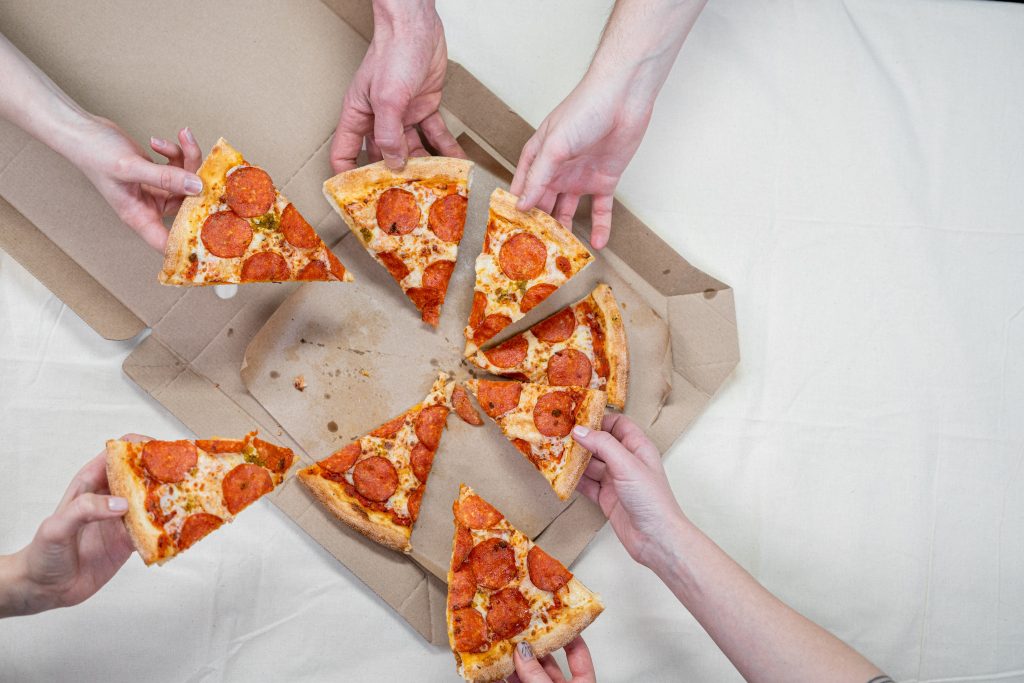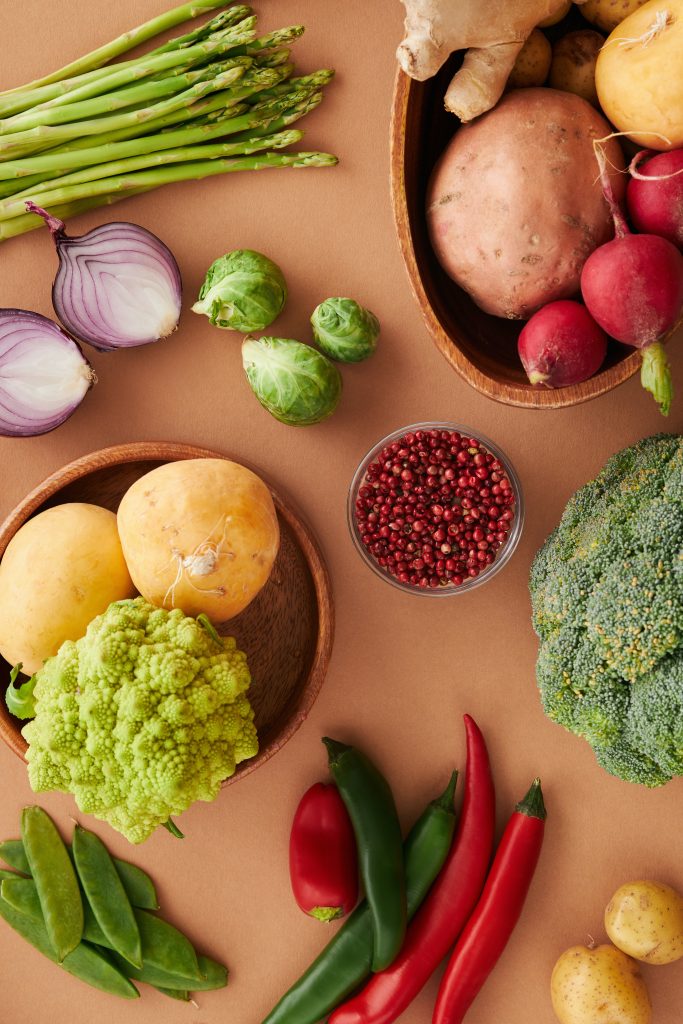Module 05: Bon appétit!
Première partie: Achetons de la nourriture! explication de grammaire
In this section:
-
Partitive Articles
-
Expressions of Quantity
Partitive Articles

In French, when talking about preferences, you will use the articles le (m), la (f) and les (pl) with food.
For example, j’adore les légumes (I love vegetables) or Je n’aime pas les œufs (I don’t like eggs). J’aime beaucoup le café (I like coffee a lot). These are called “definite articles” and indicate generalities.
However, for expressing the notion of “some” or to indicate different quantities of food or other items, you will use the “partitive“:
Partitive Forms
There are three partitive articles in French.
| Masculine: du | du pain | (some) bread |
| Feminine: de la | de la viande | (some) meat |
| Masculine or feminine before a vowel: de l’ | de l’ail (m.) de l’eau (f.) |
(some) garlic (some) water |
Uses
Partitive articles are used both in English and in French to express quantities that cannot be counted. While the indefinite article (un, une, des) is used with countable quantities (un oeuf, deux oeufs …), the partitive article is used before mass nouns, nouns that are indivisible or uncountable. In English, the article ‘some’ is often omitted.
| Comme dessert, nous avons de la mousse au chocolat, de la glace parfumée à la vanille et du sorbet à l’ananas. | For dessert, we have (some) chocolate mousse, vanilla ice cream, and pineapple sorbet. |
While the definite article designates something in its totality, or as a whole, the partitive article designates a part of the whole. Note that depending on what you want to say, the same noun may be introduced by a definite, indefinite, or a partitive article. Compare these examples:
| Vous prenez du jus, n’est-ce pas? | partitive article |
You are having (some) juice, aren’t you? (a quantity that is not specified) |
||
| Les fruits sont bon pour la santé! | definite article |
Fruits are healthy! (‘fruit’ in general) |
||
| Il y a une banane, une pomme, un pamplemousse et un ananas. | indefinite article |
There is a banana, an apple, a grapefruit and a pinapple |
After the negative
In negative sentences, du, de la, des, de l’ change to de:
| Il mange de la viande. | Elle ne mange pas de viande. | He eats meat. She does not eat meat. |
||
| Il boit du café. | Elle ne boit jamais de café. | He drinks coffee. She never drinks coffee. |
||
| Il y a encore du vin. | Il n‘y a plus de vin. | There is some wine left. There is not any wine left. |
| The partitive and indefinite articles may be used sentences to describe an unknown amount of a thing. For example: |
| Je voudrais un verre de jus d’orange. | I’d like a glass of orange juice. | |
| As-tu bu de l‘eau pendant le match ?
Elle a acheté une boîte de chocolats pour son anniversaire. Nous avons besoin de quelques morceaux de sucre pour le café.n Il a mangé une part de gâteau après le dîner. |
Did you drink water during the match?
She bought a box of chocolates for her birthday. We need a few lumps of sugar for the coffee. He ate a piece of cake after dinner. |
Notice the use of the partitive articles in the following dialogue.
| Au téléphone : Allô ? Je reçois des amis ce soir. Je voudrais faire des crêpes, mais j’ai oublié la recette. Tu peux m’aider? | On the phone: Hello? I’m having some friends over tonight. I would like to make some crêpes, but I’ve forgotten the recipe. Can you help me? | |
| A l’autre bout du fil: Rien de plus facile! Tu mélanges de la farine et des oeufs. Tu ajoutes ensuite du lait, du sel et de l‘huile. Tu verses cette pâte dans une poêle. Quand la pâte est cuite, tu garnis la crêpe avec du fromage râpé, du jambon, ou des cèpes. Mais n’oublie pas avec des crêpes, on ne boit pas d’eau. Il faut boire du cidre. | On the other line: No problem! Mix some flour and eggs. Add some milk, some salt and some oil. Pour this batter in a pan. When the batter is cooked, fill the crêpe with some grated cheese, some ham, or cepes (mushrooms). But don’t forget, with crêpes, you don’t drink water. You have to drink cider. |
Expressions of Quantity

There are many ways of expressing quantity:
-numbers (deux crêpes)
-the indefinite article (un chat et un chien)
-the partitive article (du lait, some milk)
Quantities may also be expressed using adverbs and adverbial expressions, such as assez (enough), beaucoup (a lot), or trop (too much).
When used with nouns, expressions of quantity are always followed by de (d’ if the noun begins with a vowel sound).
| Deux amis parlent. | Two friends are talking. | |
| Une douzaine de crêpes, c’est trop pour quatre personnes? | A dozen crepes, that’s too much for four people? | |
| Mais non, ce n’est pas assez. Il faut préparer beaucoup de crêpes. | No, it’s not enough. You can never prepare too many crepes. |
Here is a list of common adverbial expressions of quantity:
| assez de, enough | plein de, many | |
| beaucoup de, a lot | un tas de, a lot of | |
| un peu de, a little | trop de, too many |
Note that these expressions of quantity do not change in negative sentences:
| On ne prépare jamais trop de crêpes. | One never prepares too many crepes! |
One can express quantity by using specific nouns or adverbs of quantity, as well as measures of weight, distance, or volume, especially in reference to food. For example:
| une boîte de, a can (box) of | un litre de, a liter of | |
| un bol de, a bowl of | une livre de, a pound of | |
| un bout de, a piece (end) of | un morceau de, a piece of | |
| une bouteille de, a bottle of | une part de, a serving of | |
| une cuillère de, a teaspoon of | une pincée de, a pinch of | |
| une douzaine de, a dozen | une tasse de, a cup of | |
| 50 grammes de, 50 grams of | une tranche de, a slice of | |
| un kilo de, a kilo of | un verre de, a glass of |
The definite article (le, la, les) may be used with these expressions to indicate a quantity of a specific item. Remember that de + le and de + les form the contractions du and des respectively.
| un morceau du gâteau qu’Edouard a préparé | a piece of the cake that Edouard made | |
| un verre du vin rouge, pas du blanc | a glass of the red wine, not the white one | |
| beaucoup des invités parlent français | many of the guests speak French |
Listen to the dialogue:
| Pour une douzaine de crêpes, mélanger 400 grammes de farine et deux oeufs. Ajouter ensuite un demi-litre de lait, une cuillère de sel et une cuillère d‘huile. | For a dozen crêpes, mix 400 grams of flour and two eggs. Then add half a liter of milk, a spoonful of salt and a spoonful of oil. | |
| Le bouquet de roses et la bouteille de cidre sont sur la table! | The bouquet of flowers and the bottle of cider are on the table! |


